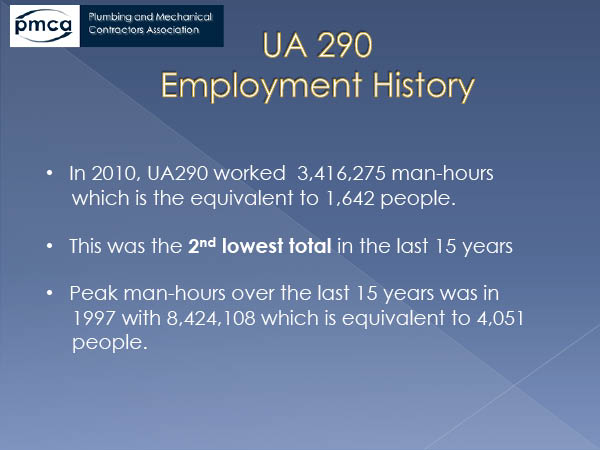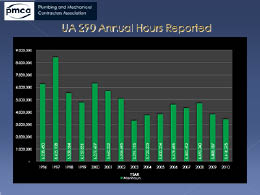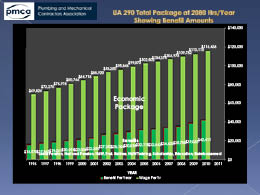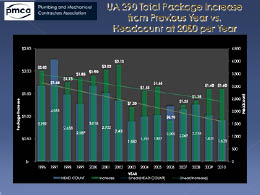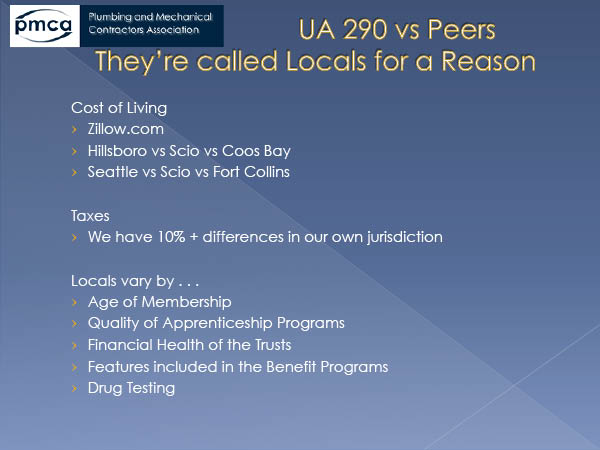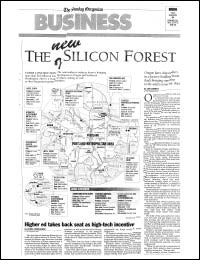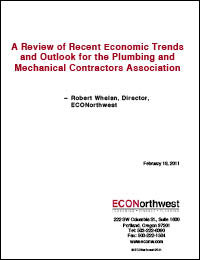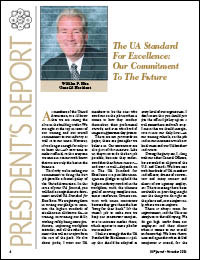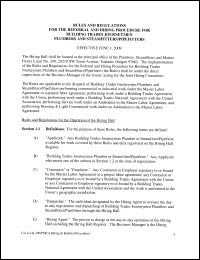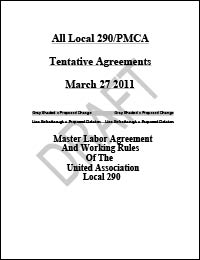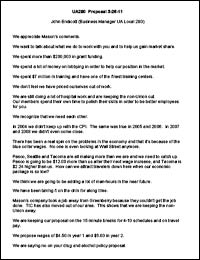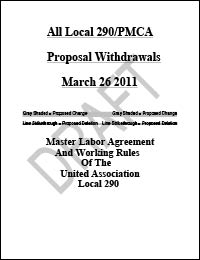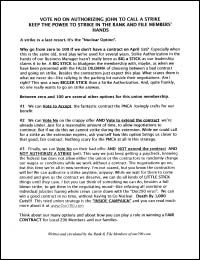2011 Contract Negotiations
Summary- Updated 4/23/11
**** Today the contract was approved by a vote: 488 yes; 442 no. ****
Click here to download the most current PMCA Negotiation PowerPoint Presentation.
Click here to read the open letter to UA 290 Members
Click here to read the AGC’s instructions to their Membership on How to Respond to a UA290 Strike
Click on here for the Trust Consultants 3 year Health and Welfare projections.
Daily Strike Update
Thursday 4-14-11
UA 290 employees continue to strike Twin Rivers Plumbing in Eugene and Bend. Twin Rivers office was picketed. Twin Rivers has operated in the community for over 30 years. More info about their company can by found at www.twinrp.com
PMC-Group also known as Portland Mechanical was selectively struck today. This is affecting over 50 employees. More info about their company can by found at www.PMC-G.com
We presented an offer yesterday to Local 290. It was for 3 years.
- 1st year 1.75
- 2nd year 2.00
- 3rd year 2.25
Tuesday 4-12-11
UA 290 employees struck Twin Rivers Plumbing in Eugene and Bend. Twin Rivers office was picketed. Twin Rivers has operated in the Eugene-Springfield community for over 30 years. More info about their company can by found at www.twinrp.com
To date, a major semiconductor facility owner and a prominent Portland GC have met with 4 major non-union piping firms (2 regional and 2 national).
John Endicott (UA Business Manager), Lou Christian (UA290 Asst. Business Manager), Frank Wall (PMCA Executive Director), and Mason Evans (Chairman PMCA Negotiating Team) met again to discuss contract issues.
Friday 4-8-11
A strike and pickets continued at Gormley Plumbing and Heating in McMinnville. Click here for the DJC’s coverage of the strike and picketing actions.
Thursday 4-7-11
Over 20 workers were instructed by their Business Manager to strike Gormley Plumbing and Mechanical in McMinnville, OR and the company’s office was picketed. Ed Gormley is a Management Trustee of UA290’s 401(k) Plan, Health and Welfare Trust, Pension Trust, Pre-Funded Retiree Health Trust, and Vacation, Scholarship & Educational Reimbursement Trust. The business is over 100 years old and Ed served as the Mayor of McMinnville for over 24 years.
Wednesday 4-6-11
PMCA Contractors attended a meeting with a major semiconductor facility owner to discuss the negative impact of the strike and refusal of overtime at their site.
John Endicott (UA Business Manager), Lou Christian (UA290 Asst. Business Manager), Frank Wall (PMCA Executive Director), and Mason Evans (Chairman PMCA Negotiating Team) met to discuss contract issues.
Tuesday 4-5-11
UA290 Members were instructed by their Business Manger to refuse all overtime starting Monday April 11.
Monday 4-4-11
PMCA member contractor, Harder Mechanical, informed International Paper in Springfield, OR that they could not complete upcoming scheduled shutdown work due to the strike. Work for over 30 men for 8 weeks was subsequently contracted to a non-union firm.
Friday 4-1-11
Over 195 UA290 workers did not show up for scheduled work at Intel’s Ronler Acres Campus.
Thursday 3-31-11
The contract between UA290 Plumbers and Pipefitters and the PMCA expired.
UA 290 Employment and Economic Proposals
Q: How many members are there in Local 290?
A: According to UA 290′s website, there are:
- 3,028 active members
- 857 retirees
- 227 Life Members (members for over 50 years).
Q: How many people are working in Local 290?
A: Please see the historical UA 290 employment graphs below.
Q: What is the history of the Economic proposals during this negotiation and how do they compare with historical raises?
A: UA290 rejected the most recent offer from the PMCA of a 3 year contract with annual increases of $1.00, $1.00, $1.25.
The Union’s current counteroffer is a $3.75/hr annual wage increase in 2011 and $4.25/hr in 2012.
Please see the slides below for the history of offers during these negotiations and a comparison of these offers with historical raises:
Q: What is the history of raises for Local 290?
A: Please see the graphs below.
Q: What are the 5, 10, and 15 year averages for wage increases in percentage terms?
A:
- The 5 year average is 2.6%
- The 10 year average is 3.2%
- The 15 year average is 3.9%
Q: What was the UA 290 contract settled for in 2009?
A: It was a 2 year contract with a $1.60 increase each year.
These amounts equate to 3.03% and 2.94% increases over previous packages.
Q: Isn’t Local 290 an employer that takes management positions in Labor Negotiations?
A: Yes. Local 290 employs members of Local 11 Office and Professional Employee’s International Union (OPEIU)
Q: What was the most recent contract settlement between UA 290 and its office staff who are members of OPEIU Local 11?
A: Last year, they settled on a 3 Year Contract with the follow economic terms.
- Freeze in Year One
- Freeze in Year Two
- Freeze in Year Three
Current Total Economic Package and Benefit Info
Q: How much does it cost to employ a Local 290 member?
A: The current total package is $55.98/hr so it costs $116,438 annually for an employer to hire a UA 290 member. $42,411 of this package is dedicated to benefits. The contract supporting this rate expires on 3-31-11.
The total package does not include contractor costs for:
- Safety staff and equipment
- Liability, Auto, and Pollution Insurance
- Construction Tools
- Construction Equipment
- Trucks
- Marketing staff and materials
- Laptops, Cell phones
- Accounting staff and systems
- Banking and Bonding Costs
- Estimating staff and systems
- Detailing staff and BIM systems
- Project management
- Executive Management
- HR
- Shop and Warehouse Facilities
- Office Space and Utilities
- Profit
- Taxes
- Legal
- Licenses
- Staff Benefits
Q: How much per hour is dedicated to UA290 benefits?
A: $20.39/hr is managed in trusts to pay for UA 290 benefits.
The remaining $35.69 is paid to the member as a taxable base.
Q: What do contractors (and customers) pay on an annual basis for UA 290 benefits?
A: In 2010, it was $42,411.
Q: What do these benefits include?
A: They include a local pension, national pension, health and welfare (health insurance), pre-funded retiree benefits, training, scholarship, and education.
Q: What percentage of the current package are benefits?
A: Benefits make up over 36% of the current total package.
Q: How have these benefits increased over time?
A: Please see the chart below which illustrates the benefit increases.
- 15 years ago benefits cost $16,578 and were 24% of the total package,
- 10 years ago benefits cost $23,358 and were 26% of the total package
- 5 years ago benefits cost $32,843 and were 32% of the total package.
Q: As a union member, these benefits seem high and keep eating up the additional money that we bargain for with the contractors. What can I do about this?
A: Please see the slide below for background and options.
Total Economic Package vs. CPI
Q: What are the Consumer Price Index increases for the last 5, 10, and 15 years in Portland?
A:
- The 5 year CPI average is 2.3%
- The 10 year CPI average is 2.1%
- The 15 year CPI average is 2.4%
Q: How does the history of Local 290 wage increases compare to the CPI?
A: Please see below for a yearly and average comparison.
Q: It has been suggested that UA 290 members are falling behind the cost of living. What would their total package be if they had received the CPI % increases for the last 15 years?
A: The graph below shows that from 1996 through 2010, the total package for UA 290 members would be $9.04/hr less if they received the CPI increase each year.
Understandably, a UA 290 member experiences the perception that they are “falling behind” in terms of purchasing power because so much of each increase has been directed toward benefit costs instead of the taxable base.
Union contractors pay the total package and feel like they are “falling behind” relative to non-union companies.
Non-union employees often receive more money on the check because their employers are able to purchase benefits at reduced costs (for UA 290 it is $42,411 annually). This allows them to present a lower price per hour to the customer.
UA290’s Total Economic Package vs. Peers
Q: How does Local 290’s economic package compare to other UA locals nationally?
A: Excluding sprinklerfitter, refrigeration, and pipeline locals, UA 290’s economic package is in the top 20% of UA locals nationally.
Q: What did the Portland Electricians (IBEW Local 48) receive as their last raise?
A: $0.80 or 1.5% for 2011.
This would equate to a raise of $0.84 for UA 290.
Q: What are the historical averages for Portland Electricians’ raises?
A: The 5 year average raise for IBEW 48 is $1.61 or 3.33%
The 10 year average raise for IBEW 48 is $1.47 or 3.37%.
Q: It seems like we have fewer people working and we are getting smaller raises each year. Is this true?
A: Yes. Please see the graph below that calculates the trends based on the reduction in UA 290 man-hours and the bias toward smaller raises each year.
- This graph shows that employment is falling faster than wage increases.
- The trend line for a 2011 wage increase points to $1.30 increase based on this historical data.
Q: It seems like the UA Members in other locals all have contracts where they make more money?
A: Some do, most don’t, and the grass always seems greener somewhere else.
All 350 of the UA locals serve different markets and have unique language and wage structures. Please see the following slides that highlight these differences and ultimately prove that you shouldn’t cherry pick language and wages from other locals.
Instead, you should negotiate a contract based on the market in your jurisdiction and not what someone did or didn’t get up the road.
Work Outlook
Q: Isn’t Intel going to employ everyone in the local?

A: It’s great to have this investment in our region, but we must be cautious of putting all of our eggs in one customer’s basket.
Intel will not employ a predominance of the service contractors, down-state union members, plumbers, or refrigeration hands.
Diversity amongst services, industries, and geography helps the UA maintain stability and ultimately protects its members and the value of their future pensions.
All big jobs come to an end and we don’t want to look around after D1X and see that the non-union sector has moved in and taken away our historical markets.
Q: Remember when there were 10 semiconductor facilities in the state being built?
A: Currently, we have 1 major semiconductor expansion announced (D1X) and possibly another solar facility.
Click the image below to download an article from the Oregonian in 1995 that lists 10 semiconductor facilities under construction.
Of the facilities listed:
- 4 are in limited operation and employ minimal construction workers.
- 3 are shutdown/bankrupt
- 1 was converted to a solar facility
- 2 are major construction employers and growing.
Q: What are the recent economic trends in our area and what is the outlook for work?
A: The PMCA commissioned ECONorthwest to evaluate economic data affecting the local construction market and comment on the prospects of our market sector.
ECONorthwest conclusions are as follows:
- The Great Recession had a lower peak than 1982, but was more heavily concentrated in housing and construction.
- The number of plumbers and pipefitters working in Oregon has continued to decline (even in non-recession years).
- Inflation on the consumer level is going up over the next 2 years.
- It is benefits (not wages) that have increased far faster than the inflation rate for UA 290 members.
- It will be many years before housing returns to mid-2000 construction employment levels.
- The outlook for non-residential construction is better than residential.
- Water, wastewater, pipeline, power & utility markets have a stable outlook.
- Debt levels vs. revenues (taxes collected) at the state and local government levels are at their widest levels in 35 years.
- With pension liabilities counted as debt, Oregon ranks as one of the worst states for debt-revenues ratios.
Click on the image below to download the full report.
Market Share/Non-Union Competition
Q: Historically, what percent market share goes union in the Oregon area?
A: 40% of plumbing and pipefitter work is performed by union construction workers according to the Construction Labor Research Council (CLRC)
Please click here for the CLRC data:
Q: The data shows that we have fewer people working, our benefits cost more each year, and the non-union firms are taking our market share. Is this true?
These long term trends of reduced union employment (and concentration in urban specialty markets) create a negative cycle and point to several difficult realities for our industry.
- Reduced plumber and pipefitter employment strains retirement, apprenticeship, and healthcare trusts that are dependent on man-hours to meet future obligations
- To counter this trend, wages and benefits are increased to “catch up.” These dramatic wage package increases put union contractors at a cost disadvantage to non-union firms
- This strain is evidenced by the 40% reduction in PMCA Member Contractors over the past 15 years.
- With fewer contractors bidding work, the non-union sector goes unchecked and is allowed to grow and increase its market share
Q: What is local 290′s goal for market share over the next 7 years?
A: There is not a formal goal published at this time.
Q: What major contractors have been organized (converted from non-union to union) or newly established in the last 5 years?
A: No major contractors have been converted or organized in the last 5 years. The number of employers has dropped from over 250 to 139.
Q: Who are the largest non-union employers in the area and what jobs have they recently won?
A: The largest non-union employers in the area include:
- Greenberry Industrial
- Oregon Cascade
- American Heating
- Phoenix Industrial
- JRT
- Hydro-Temp.
- Big J Mechanical
Please see their websites for additional information.
Q: What major projects were built non-union?
A: Major projects include:
- Oregon State Hospital
- University of Oregon Matthew Knight Arena
- Sandy HS.
Q: How big are these jobs and who is hiring them?
A: Over the past 2 years, a record amount of large projects including several in excess of $10mm have been awarded to non-union contractors by top tier GC’s.
Q: What happens if we present our customers with large wage increases, costly new work rules, or the threat of strikes and pickets?
A: Customers handle their money like most people handle their personal finances.
- They want to know they are getting a good value when they buy something.
- They don’t like seeing inefficient rules that slow things down.
- If you don’t show up or aren’t dependable, they will find other people that they can count on.
Our customers always have choices and if we push unnecessary problems on them, they will find non-union alternatives. It’s never a good idea to poke a bear.
Q: Can you give me an example of another UA Local and their Contractor Association that has taken progressive steps to jointly grow marketshare?
A: Yes. District Council 16 in Los Angeles and the CPMCA have undertaken a joint effort to increase the union marketshare in their region by 25% in 10 years. Please see 2 of their slides below which outline their philosophy on marketshare and recent negotiation goals. We will make more information available soon on this innovative partnership.
Q: I’m concerned about the future of union construction and its ability to capture market share (and pay for my future pension). What strategies are out there to increase market share for the union worker and contractor?
A: The MCAA commissioned the attached study to highlight the best practices related to regaining market share.
Click here to read the MCAA White Paper.
Some of these strategies involve drastic changes and others require an improvement in teamwork between labor and management.
All of the recommendations will require effort from both sides and a willingness to work together to change and grow our industry.
Q: What are the Top Strategies for Regaining Local Market share based on this MCAA White Paper study?
- Improve craft productivity through training, recruitment, and progressive discipline of consistent poor performers.
- Reduce crew costs with differential wage rates and sub-journey worker classifications.
- Allow portability of union member manpower across local union jurisdictional boundaries without restriction or prior approval.
- Allow unrestricted importation of union-fabricated piping assemblies of all types across local union jurisdictional boundaries without restriction or prior approval.
- Adopt the Standard for Excellence.
- Promote UA/MCAA Foreman Training and Certification Program.
- Implement accelerated training and direct entry of pipe trades workers.
- Update/adopt Substance Abuse and Testing Policy in line with the CURT/BCTD work product.
- Incorporate an arbitration clause with a no-strike/no lockout pledge to limit customer disruption during contract negotiations.
- Address disparities in overtime pay between the union and non-union construction worker.
- Update the apprenticeship system to appeal to the new workforce.
Q: What are the Greatest Barriers to Regaining Market share based on this MCAA White Paper study?
- Local management/multiemployer bargaining units function as weak, fractured, and compliant bargaining partners
- Local labor groups have exploited bargaining advantages with owners under project and national agreements to serve short term political interests.
- A Regulated Fringe Trust threatens the viability of contributing employers.
- Full employment complacency cedes an increasing market share to open shops.
- Political dynamics of Local Union leadership.
- Restrictive Hiring Hall Rules and Regulations
Demographics/ Retirement Info
Q: How many local 290 members are expected to retire in the next 7 years?
A: UA 290 will make this information available
Q: How many apprentices are scheduled for earning Journeyman status over the next 7 years?
A: UA 290 will make this information available
Q: What is the most common year of birth for UA 290 members?
A: 1952
Drug Testing
Q: What is the history of the Drug Testing program?
A: A joint labor and management team was selected to develop a program at the conclusion of the last contract negotiations.
Q: Who worked on the program?
A: The Drug Program that was jointly developed by UA 290 members, PMCA representatives, and industry professionals.
Q: Did the Drug Testing Subcommittee complete their task?
A: Yes. The Drug Testing Subcommittee drafted a program and recommended it to their respective negotiating committees for adoption by labor and management.
Q: Can I get a copy of the proposed Drug Testing program?
A: Click the image below to download
Q: Does the proposed Drug Testing policy include random testing?
A: Yes
Q: Who will pay for the drug program?
A: The program will fund a contractor funded accrual of 5 to 10 cents per man-hour that will be used to pay a 3rd party to administer the program.
No out of pocket money for the UA 290 member.
Contractors will no longer have to pay to administer their own programs and our customers will get the assurance of a workforce that is committed to a meaningful drug testing program that is collectively funded.
Q: Isn’t having a drug free workforce an important message to send to our customers and our members about our respect for the law and the safety of our workers, customers, and the public?
A: Yes
UA Local 290 is the only local construction trade union that currently does not have a drug policy that meets minimum standards for major customers and general contractors.
Standard of Excellence
Q: What about the Standard of Excellence?
A: Please watch the video from UA International President Billy Hite endorsing the Standard of Excellence.
Click on the image below to read Billy Hite’s article on the Standard of Excellence.
Q: What does the Standard of Excellence really say?
A: Please click on the attached link to read a copy of the Standard of Excellence.
PMCA, Voting, and Existing Contract Info
Q: Who negotiates the contract?
A: The PMCA Negotiating Committee and Local 290′s Negotiating Committee meet over a 1-2 month period prior to contract expiration to put forth a joint proposal for the members for a general vote.
Q: Who does the PMCA represent?
A: The PMCA represents over 139 contractors that work in UA 290′s jurisdiction and are signatory to the local collective bargaining agreement.
These companies work on highly complex and diverse mechanical projects such as large scale refrigeration and cooling systems, gas pipelines, medical gas systems in hospitals, and computer chip manufacturing facilities.
On average, PMCA companies employ over 2,000 tradespeople to perform service, new construction, and maintenance work and are on the leading edge of green building systems to improve a facility’s plumbing, process, heating, and cooling systems.
Q: Where can I get a copy of the current contract?
A: It is available through the UA 290 training centers and published on the PMCA’s website.
Q: What is the format for voting?
A: It is a written ballot and a person must be present at a special Union Meeting in Portland to vote.
Q: How many people were eligible to vote in the last negotiations?
A: 3,500
Q: How many people voted in the 2009 election?
A: Just over 1000.
This equates to a voter turnout of less than 30%
Q: What is the jurisdiction of UA Local 290?
A: The jurisdiction includes portions of SW Washington, Northern California, all of Western Oregon and a portion of Eastern Oregon.
Dispatch points for existing for travel zones and training centers are also noted.
Q: This seems like a large geography for a person to vote in person in Portland on a weekend with less than 1 weeks notice?
A: It is over 411 miles each way for some members to travel to vote in an election. This format is not democratic and skews voting results.
History and Content of 2011 Contract Offers and Voting Results
4-3-11 Contract Vote
On Sunday 4-3-11, UA290 rejected the PMCA’s 3-31-11 proposal as noted below.
The results of the vote on the proposal were:
- In Favor of PMCA Proposal 94(Yes)
- Against PMCA Proposal 945 (No)
A second vote on whether to give the UA 290 strike committee authorization to enact a strike was passed.
The results of this vote were:
- Authorization to Strike 900 (Yes)
- No Authorization to Strike 90 (No)
The contract expired Thursday 3-31-11.
A federal mediator has been notified.
The parties will attempt to meet this week.
Please see other sections of this website for FAQ’s on Strike Actions.
It is our information at this time that the Local 290 membership was told to be at work on Monday.
It is the PMCA’s understanding that in the future, at the Business Managers discretion, there is a possibility that select jobsites will be manned while other jobsites will be targeted with pickets and not be manned by UA290 Members.
(Voter turnout was 30% based on 3500 eligible voters. Members must vote in person at the Portland Convention Center.)
The 3-31-11 Proposal that was rejected is as follows:
Wages:
- Increase of $1.00 in 2011
- Increase of $1.00 in 2012
- Increase of $1.25 in 2013
Language:
- Letter of Understanding recognizing the UA Standard of Excellence
- Plumbing and Pipefitting Industry Drug-Free Workplace Policy as revised on 2/10/11.
- 25 Language proposals as outlined on this attachment
3-31-11 Bargaining Session
On 3-31-11, UA 290 and the PMCA held their 8th bargaining session which lasted for 5 hours bringing the total meeting time to over 40 hours.
Click here to download the meeting minutes.
The PMCA proposed the following:
Wages:
- Increase of $1.00 in 2011
- Increase of $1.00 in 2012
- Increase of $1.25 in 2013
Language:
- 25 Language proposals as outlined on this attachment
- Letter of Understanding recognizing the UA Standard of Excellence
- Plumbing and Pipefitting Industry Drug-Free Workplace Policy as revised on 2/10/11.
- Retain existing language on break duration for 4-10 shifts
- Retain existing contract travel rates
UA290 proposed the following counter offer:
Wages:
- Increase of $3.75 in 2011
- Increase of $4.25 in 2012
Language:
- 25 Language proposals as outlined on this attachment
- Letter of Understanding recognizing the UA Standard of Excellence
- Reject the Plumbing and Pipefitting Industry Drug-Free Workplace Policy as revised on 2/10/11.
- Increase breaks from 10 to 15 minutes when working a 4-10 shifts
- Increase travel rates as noted below.

The PMCA requested that UA290 vote the PMCA offer as made on 3-31-11.
Q: Can I get a transcript of the economic offer as it was presented by the PMCA on 3/26/11?
A: Please see the attached transcript.
Q: Can I get a transcript of the economic offer as it was presented by the UA290 on 3/26/11?
A: Please see the attached transcript.
3-27-11 Contract Election Results
On 3-27-11, UA 290 rejected the PMCA’s proposal consisting of the following.
Wages:
- Increase of $0.75 in 2011
- Increase of $1.00 in 2012
- Increase of $1.25 in 2013
Language:
- 25 Language proposals as outlined on this attachment
- Letter of Understanding recognizing the UA Standard of Excellence
- Plumbing and Pipefitting Industry Drug-Free Workplace Policy as revised on 2/10/11.
The vote on the contract was a voice vote to reject.
A second vote on whether to give the UA 290 strike committee authorization to enact a strike was also rejected.
The results of that vote were:
- Authorization to Strike 411 (Yes)
- No Authorization to Strike 480 (No)
(Voter turnout was 25% based on 3500 eligible voters. Members must vote in person at the Portland Convention Center.
The contract expires Thursday 3-31-11.
A bargaining session is scheduled for 3-31-11.
A vote has been scheduled for Sunday 4-3-11.
Q: What is the PMCA’s current Language Proposal?
A: As of 3-26-11, 25 Language proposals that were tentatively agreed to by the negotiating committees are available in the document below:
Q: Does the most recent Language Proposal include the UA Standard of Excellence?
A: Yes, the Standard of Excellence was tentatively agreed to in the most recent contract proposal. It was agreed to be included and printed in the contract and referenced by a mutual Letter of Understanding.
Q: Does the most recent Language Proposal include the jointly developed UA290/PMCA Drug Testing Program?
A: Yes, the Plumbing and Pipefitting Industry Drug-Free Workplace Policy (draft 2/10/11) that was jointly developed by the UA290/PMCA/Industry Expert Subcommittee was included in the most recent language proposal. This program includes random testing and new testing limits.
Q: What proposed language was withdrawn as part of the bargaining process?
A: Please see the attached document showing 29 withdrawn proposals through 3-26-11.
Strike/Lockout/Inside Campaign Info
Q: Can the Union stop employees from working?
A: Absolutely not. All employees can work if they want.
Q: If there is a strike, will the contractors operate?
A: Yes. The contractors are prepared to operate and service all of their customers.
Q: Do striking employees get paid unemployment benefits?
A: No. If employees choose to strike, the contractors do not pay them. Under Oregon law, striking employees generally are not eligible for unemployment compensation.
Q: Can employees still go to work if the Union calls a strike?
A: Yes. Whether employees decide to work or not is solely their decision. It is illegal for either the contractors or the Union to threaten or intimidate employees in deciding what they want to do.
Q: Can the Union penalize members who decide to cross a picket line and work?
A: It depends on what the Union’s Constitution and Local Union By-Laws provide. But normally, under its Constitution or By-Laws, a Union can fine or penalize any member who works during a strike.
Q: If employees are Union members and want to work after a strike starts, is there any way they can avoid a potential fine or penalty from the Union?
A: Yes. Under the National Labor Relations Board’s rules, an employee who wants to work and avoid any fines can do one of two things: resign from the Union or change membership status to “financial core.” Legally, employees can resign from the Union any time after the contract expires. If employees wish to resign from the Union, they should send or hand-deliver a letter to the Union stating so. Resignations will be effective upon receipt of the letter by the Union. However, remember that if employees want to join the Union after the strike, they may have to pay a new initiation fee.
Q: Is there a way to avoid the risk of having a new initiation fee?
A: Yes. Employees may change their membership from that of a full member to what is called a “financial core” member. This means employees continue to pay the regular dues required of all regular members, but the Union may not subject them to any other obligations of membership and may not fine them for crossing a picket line. The Union cannot require an initiation fee from employees if they become a “financial core” member.
Q: Can you provide some information on the alleged Inside Campaign that is being promoted by some UA290 members as a bargaining strategy to be used against the contractors?
A: Please see the recent handbills regarding the alleged Inside Campaign.
Responses to Rumors
Q: Does the Contractor get to charge the customer double benefits for overtime and then keep these funds for themselves?
A: See attached flyer from UA290 Member.
No, contractors do not get to charge benefits for OT hours. Customers and the marketplace do not allow for this.
Q: Is their going to be a separate scale for plumbers and pipefitters?
A: This has not been proposed and is very unlikely.
Q: Why was the Letter of Understanding recognizing the uniqueness of the plumbing and pipefitting crafts on page 38 of the previous contract left out of the last contract?
A: Despite the conspiracy theories, this was an oversight from the printers and multiple parties from Labor and Management that reviewed the drafts.
It was not bargained to be removed, so Management acknowledges that it existed in the last contract.
As we enter negotiations, this clause like every other clause in the MLA and Hiring Hall Regulations is subject to negotiation for removal, modification, or no change.
This oversight was not recognized for over 2 years by either party.
Q: What happened at the last negotiating meeting?
A: Click here to download the minutes.
Additional Pages
Summary
Daily Strike Update
UA 290 Employment and Economic Proposal
Current Total Economic Package and Benefit Info
Total Economic Package vs. CPI
UA290’s Total Economic Package vs. Peers
Work Outlook
Market Share/Non-Union Competition
Demographics/Retirement Info
Drug Testing
Standard of Excellence
PMCA, Voting and Existing Contract
History and Content of 2011 Contract Offers and Voting Results
Strike/Lockout/Inside Campaign Info
Responses to Rumors

